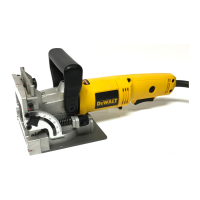ENGLISH
30
d) Remove any adjusting key or wrench
before turning the power tool on. A
wrench or a key left attached to a rotating
part of the power tool may result in personal
injury.
e) Do not overreach. Keep proper
footing and balance at all times. This
enables better control of the power tool in
unexpected situations.
f) Dress properly. Do not wear loose
clothing or jewellery. Keep your hair,
clothing and gloves away from moving
parts. Loose clothes, jewellery or long hair
can be caught in moving parts.
g) If devices are provided for the connection
of dust extraction and collection facilities,
ensure these are connected and properly
used. Use of dust collection can reduce
dust-related hazards.
4) POWER TOOL USE AND CARE
a) Do not force the power tool. Use the
correct power tool for your application.
The correct power tool will do the job
better and safer at the rate for which it
was designed.
b) Do not use the power tool if the switch
does not turn it on and off. Any power
tool that cannot be controlled with the switch
is dangerous and must be repaired.
c) Disconnect the plug from the power
source and/or the battery pack from
the power tool before making any
adjustments, changing accessories, or
storing power tools. Such preventive safety
measures reduce the risk of starting the
power tool accidentally.
d) Store idle power tools out of the reach
of children and do not allow persons
unfamiliar with the power tool or these
instructions to operate the power tool.
Power tools are dangerous in the hands of
untrained users.
e) Maintain power tools. Check for
misalignment or binding of moving parts,
breakage of parts and any other condition
that may affect the power tool’s operation.
If damaged, have the power tool repaired
before use. Many accidents are caused by
poorly maintained power tools.
f) Keep cutting tools sharp and clean.
Properly maintained cutting tools with sharp
cutting edges are less likely to bind and are
easier to control.
g) Use the power tool, accessories and
tool bits etc., in accordance with these
instructions taking into account the
working conditions and the work to
be performed. Use of the power tool for
operations different from those intended
could result in a hazardous situation.
5) SERVICE
a) Have your power tool serviced by a
qualified repair person using only identical
replacement parts. This will ensure that the
safety of the power tool is maintained.
Additional Specifi c Safety Rules for
the Biscuit Jointer
• Disc cutters must be rated for at least the
speed recommended on the tool. Disc cutters
running over rated speed can fly apart and
cause injury.
• Always use the guard. This protects the
operator from broken disc cutter fragments and
unintentional contact with the disc cutter.
• MAXIMUM allowed disc cutter diameter is
100 mm.
• DO NOT use blunt or damaged disc cutters.
• Check the proper function of the guard
retracting system before use.
• Wear a dust mask. Exposure to dust particles
can cause breathing difficulty and possible
injury.
• Always ensure that the power tool is switched
off before plugging into the mains.
• Do not switch off before the blade is running
freely.
• Remove all nails and metal objects from the
workpiece before starting work.
• After switching off, never attempt to stop the
blade by pressing against the side of the blade.
• Never put the tool down on a table or
workbench unless switched off.
• The tool must only be used for cutting wood
or plastic.
• Ensure that all devices screening the blade are
in perfect working order.
• Never put the tool down on a table or
workbench unless switched off.
• Only blades conforming to the specifications
contained in these operating instructions may
be used.
• Blades made of high alloy, high-speed steel
(HSS steel) should not be used. Best results are
achieved using carbide-tipped or CrV blades.

